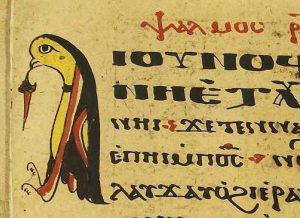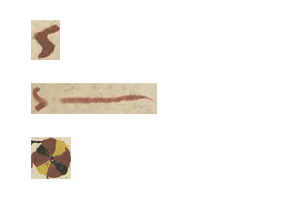About this manuscript
This is a collection of seven texts related to John the Baptist. Five of them are liturgical texts, to be read or sung during services dedicated to John the Baptist. These texts are bilingual: in Bohairic - the form of Coptic that came to be reserved for the liturgy of the Coptic Orthodox church – with an Arabic translation. The other two texts are homilies written exclusively in Arabic, the daily language of many Christians in the Middle East.
One of the colophons is dated Amshir 29, 1360, that is March 8, 1644. Five more texts have colophons (in Arabic), which tell us that the entire bilingual codex was copied by Ṣaliḥ b. Jirjis al-Dīwān, then archdeacon in Jerusalem. A waqfiyya (endowment deed) in Arabic (see f 68a in the frame) states that, on the same day the codex was finished, it was “donated perpetually” to the Church of the Resurrection (Holy Sepulchre) in Jerusalem. The Coptic Orthodox Patriarchate of Jerusalem was established upon its roof, at the monastery called Dayr al-Sultan.
It was a valuable present. The manuscript is richly adorned with decorations in red, yellow and gold ink. Among them is a bird-like figure for the capital A (f 3v), which Ṣaliḥ b. Jirjis the archdeacon did not draw perhaps quite as well as some of his colleagues in an earlier period had done, like the one illustrated below from a manuscript of the Mingana Collection of Middle Eastern Manuscripts, Arabic 61 Coptic 2, ff 8,9. Cadbury Research Library: Special Collections, University of Birmingham.

But Ṣaliḥ had other skills. He planned the compilation of the codex very cleverly, possibly copying it from a model. The volume consists of eight quires of five bifolios each – the most common size of a quire in the Middle East (see Lesson 3). Ṣāliḥ worked from left to right for the Coptic-Arabic texts, and from right to left for the homilies in Arabic. In both languages, the collection opens with a text about the birth of John the Baptist. On folios 55b and 56a the two parts meet, without blank pages or a change in the number of bifolios per quire.
1 > 2 > 3 > 4 > 5 | 6 < waqfiyya < 7
The Coptic and Arabic part have their own styles of text dividers, to help the reader recite fluently during a service. In the Coptic part the end of sentences is marked by

a small s,
and the end of paragraphs is marked by an s and a line,
In the Arabic text a rosette is used as a text divider.
Further reading
Horner, G., The Coptic version of the New Testament in the Northern dialect, otherwise called Memphitic and Bohairic, Oxford 1898, vol. I (Matthew, Mark), vol. II (Luke, John).
Graf, G., Geschichte der christlichen arabischen Literatur, Vol. I, Vatican city 1944, 337-338 (John Chrysostom), 444 (Jacob of Sarug).
J.J. Witkam, Inventory of the Oriental Manuscripts of the Library of the University of Leiden, Vol. 15: Manuscripts Or. 14.001-15.000, pp. 186-187.
Questions
-
How are the beginnings of each text indicated?
-
A deed of bequest or waqfiyya was usually written last, after the text of a volume was finished. Which other of the seven texts in this codex was copied on the same day as the waqfiyya? In what order were the codex's seven texts apparently copied?
Assignments
-
(Recommended font: Antonious)
Create your own edition of a Coptic section from the New Testament as preserved in Or. 14.404, using the Leiden system. (for instance ff 19b-20a/Matthew 11:11-19; ff 44b-46a/Matthew 14:1-12; ff 37a-38a/Marc 1:1-8.)
-
Compare your own edition of Or. 14.404 with Horner’s edition and include variations in the critical apparatus.
